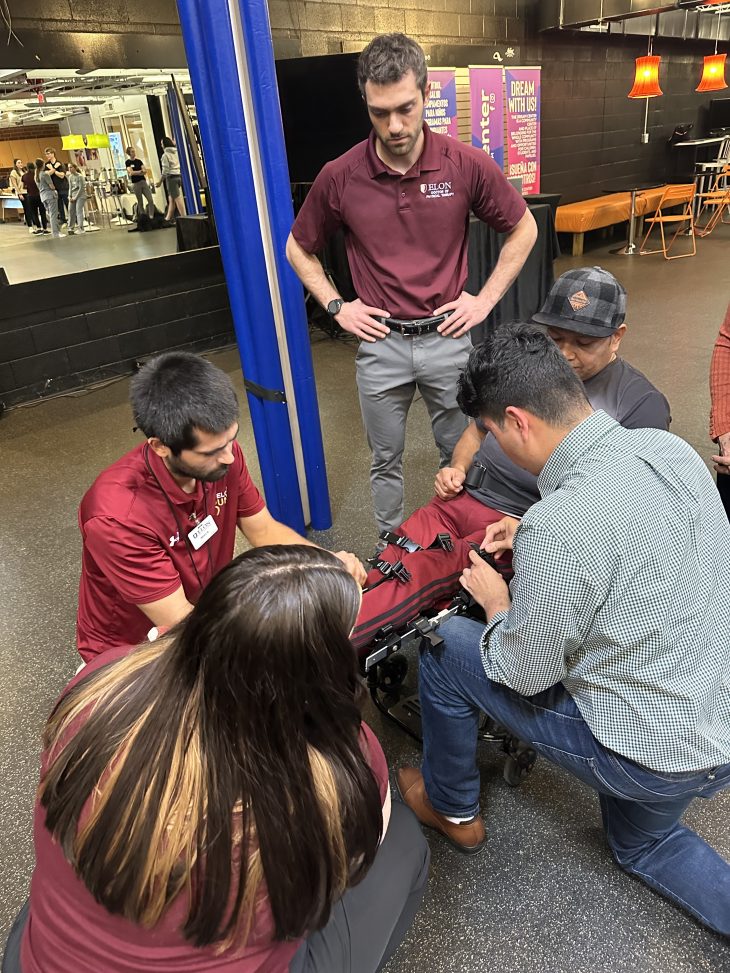An innovative partnership between the Department of Physical Therapy Education’s HOPE Clinic and the Engineering Department delivers a cost-effective bracing solution, enabling mobility for a spinal injury survivor.
The Health Outreach Program at Elon (HOPE) Clinic is a pro bono physical therapy clinic offering services to uninsured and underinsured individuals in Alamance County and the surrounding areas. Many patients face substantial financial barriers, particularly in acquiring essential medical support/services and equipment like braces. Such was the case of a client diagnosed with transverse myelitis, a rare inflammatory neurological disorder affecting the spinal cord, in 2019. As a result, the client needed to use a wheelchair for mobility.

During his initial appointment at the HOPE Clinic in 2023, the client relied on the support of three Doctor of Physical Therapy students to walk distances of 5 to 15 feet because he could not stand without assistance or propel his legs forward. Following months of dedicated therapy, the client made significant strides, transitioning to walking with the aid of two DPT students. However, to achieve complete independence in walking, he required appropriate bracing. Since customized braces cost several thousand dollars, providing that assistance was likely going to be cost-prohibitive.
This is when the HOPE Clinic partnered with Professor Sirena Hargrove-Leak in the Department of Engineering. Hargrove-Leak offered her class, Engineering Design for Service (EGR 2210) as a partner to the HOPE Clinic for the Fall 2023 semester. The course emphasizes the commitment by engineers to serve the needs of others and consider the well-being of those they serve. Students work in small teams to apply the engineering design process to design devices or systems to help people in the local community.
In Fall 2023, two teams of engineering students worked to design and build bracing to help this client. One team focused on the knee and another team focused on the ankle. The members of the “knee team” were Maggie Dion, Jacob Karty, Jesus Santoyo Rosales and Gerry Tejado. The members of the “ankle team” were Nadia Aho, Diego Hernandez and Talton Mickle. By the end of the semester, the “knee team” designed and built one fully functional brace, while the “ankle team” identified a reasonably priced off-the-shelf solution and designed potential ways to modify it to meet the specific needs of the client.
The project strongly aligned with the interests of “ankle team” member and Honors Fellow Diego Hernandez, a member of the Class of 2026. “It has been one of the most rewarding experiences I’ve had and has shown me that helping people with some form of disability is what I want to do with the rest of my life,” Hernandez said.
Even after the conclusion of the Engineering Design for Service course, Hernandez has continued work on the project. During Winter Term, he built a second knee brace for the client using the design developed by the “knee team.” For his Honors Fellows research project over the next two years, Hernandez aims to complete the work on the ankle brace and design an effective way to connect the knee and ankle braces to further enhance the client’s experience.
Through this powerful collaboration between the HOPE Clinic and Hargrove-Leak’s class, two braces have been created for the client that have allowed him to walk independently with a walker for over 120 feet.
“When I first joined his treatment team, three people had to physically advance his legs and hips for him to walk,” said Kaitlyn Carpenter, a second-year DPT student. “At his last session, he was able to walk completely on his own with a walker. His walking is even better with the custom knee braces designed by Elon engineering students. His progress has been incredible, and it is rewarding to know that we helped him gain more independence and reach his main goal of walking around his home and in the community.”
The knee braces have been invaluable for the client. The DPT students assessed endurance with and without the braces. Without the braces, the client walked 45 feet in 2 minutes and 41 seconds. With the braces, he walked 121 feet in the same time frame. Gains of this magnitude are remarkable and indicate a reduced fall risk and improved efficiency with mobility.
“Through this project, I gained a deeper appreciation for the collaborative nature of problem-solving with people from different disciplines,” Hernandez said. “Moreover, I came to understand the importance of aligning our product with the needs and expectations of our patients. By actively engaging with the patient and gathering feedback throughout the development process, we were able to iterate and refine our product to better meet his needs.”
Hernandez is excited to continue to help this client grow and improve even more.



